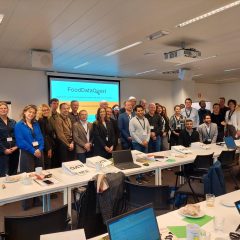Dossier Food: balanced and healthy
- Food processing
- Food safety
- Shelf life
- Food quality
- Taste and aroma
- Mouthfeel
- Health
- Food-related disease
- Digestion
- Health promotion
- Chewing and swallowing problems
- Nutrition for target groups
- Allergens
ILVO strives for nutritionally balanced, safe, and tasty food for a growing global population, within a sustainable and economically healthy framework. How can both primary production and the processing industry – as important links within the agri-food system – contribute to this?

What does ILVO do?
-
 ILVO studies which basic ingredients can be produced in Flanders with a high nutritional content and health-promoting components.
ILVO studies which basic ingredients can be produced in Flanders with a high nutritional content and health-promoting components. -
 ILVO has expertise and facilities for product and process innovation and performs highly specialized nutritional analyses.
ILVO has expertise and facilities for product and process innovation and performs highly specialized nutritional analyses. -
 ILVO develops prediction models for optimization of recipes, including using taste testing and consumer acceptance evaluation.
ILVO develops prediction models for optimization of recipes, including using taste testing and consumer acceptance evaluation. -
 To ensure that healthy food is also produced in a sustainable way, ILVO applies life cycle analysis (LCA).
To ensure that healthy food is also produced in a sustainable way, ILVO applies life cycle analysis (LCA). -
 ILVO’s expertise in nutritional physiology is applied to the pig as a model system to study the link between diet and health.
ILVO’s expertise in nutritional physiology is applied to the pig as a model system to study the link between diet and health.
Diet and Health … more than a gut feeling
In the course of time our Western diets and dietary habits and patterns have changed. Currently, our society has a growing understanding and interest in balanced diets and their role in our (mental and physical) health. In our daily life, the relationship between diet and health is also taking a more prominent role. Increased media attention, practically unlimited choices of (often new) food products and ever-growing scientific knowledge about this relationship, are sure to increase this societal awareness.
This subject is therefore increasingly coming to our attention through all kinds of channels (which may or may not be scientifically substantiated). But how can we still see the forest for the trees? Or should we say: see the mash for the potatoes? There are a lot of questions:
- What is and isn’t a healthy diet, or should we speak more of balanced diets and balanced dietary patterns?
- What about so-called superfoods; just how super are they?
- Are there any officially recognized health claims?
- Is what’s good for me also good for my neighbor?
- As a producer, can you go in just any direction?
- Is food with a perfect nutritional score (in theory) also suitable in practice (technically-functionally) for experiencing tasty food products?
- And what about food safety?
And as if it wasn’t complex enough… how can we ensure that nutritionally adequate food can be produced in sufficient quantities to feed the growing global population, at a fair and accessible price, within a sustainable context? Moreover, this isn’t a static fact; it’s fairly dynamic with a wide range of interacting factors and actors, across numerous disciplines.
How are things really going?
Despite the growing awareness and attention for balanced nutrition, our society is suffering from malnutrition. This concerns both under- and overeating(!). In both cases, an unbalanced diet means that the daily nutritional needs are not being met. This in turn contributes directly or indirectly to the occurrence of food-related chronic diseases. Think of the increase of people with obesity, diabetes, cardiovascular diseases, etc.
The nutritional needs of people in general, or of specific age and target groups (e.g. children or pregnant women), have already been identified and can be consulted in scientific reference books, like those from the World Health Organization, for instance.
However, when interpreting this information and recommendations, you must take into account differences in bioavailability and/or bioactivity depending on the food matrix in which these nutrients occur.
We don’t eat ingredients, we eat meals
Interactions between components or with the food matrix, influence of processing – which can be both nutritionally positive (e.g. increased bioavailability) and negative (e.g. loss of health-promoting components), influence on and of our intestinal flora, etc. are all factors that make the influence of food on our health a complex issue and require further research within different domains and disciplines.
And ‘we’ are all different
Although balanced nutrition plays a crucial role for each of us, the general needs differ from target group to target group or from individual to individual, for example, in the context of illness, age, or activity level (e.g. athletes). For example, a sufficiently high and nutritionally adequate protein intake is a point of attention for the increasing number of elderly people in our population, among which sarcopenia or loss of muscle mass/function can occur. Providing tasty, recognizable, and chewable foods for people with swallowing/chewing problems, such as Parkinson’s disease patients, is another example.
A wide range of opportunities...and some obstacles too
Fortunately, our agri-food system, with its field-to-fork concept, offers sufficient opportunities to provide food with a high nutritional quality and good food safety, so consumers can create a balanced diet according to their needs. The primary plant and animal producrs can supply sufficient, high-quality raw materials with a wide range of nutrients and health-promoting components such as fibers, anti-oxidants, omega fatty acids, etc. The other links in the chain also play a crucial role, via harvest and storage and further processing to stabilize those primary raw materials. When done well, processing can even increase the bioavailability of certain desired food components.
Of course one cannot forget that this is all happening within a framework that creates opportunities as well as obstacles: legislation, food security, sustainability, pricing, marketing, cultural habits, business models, economic profitability, and so on. These are but a few of the many aspects that also require attention within this complex agricultural-food-health concept where social sciences and technological sciences must come together within a multi-/inter-/transdisciplinary framework.
Research projects











